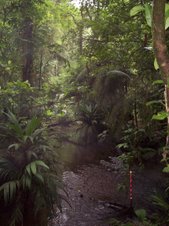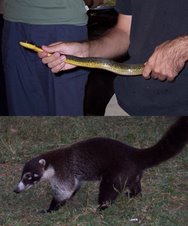Anyway, here are the hypotheses that I've developed at this point. I likely won't test all of these questions now (too much for one project), but will choose between the most relevant and testable. Seeing as I'm about to go present them to Tom (wish me luck!), and we're discussing hypothesis-framing in class tomorrow, this seems like a good time to put them out there for comment. So, here goes - let me know what you think!
Dissertation questions/hypotheses:
Overarching: 1) what mechanisms are responsible for the decline of understory insectivorous birds in tropical rainforest?
2) Does a trophic cascade exist (can one exist w/in such a highly diverse environment), and if so what are the strengths of the various direct and indirect effects (model this w/ path analysis, per Lee)
Hyp 1) Abundance of leaf-litter and understory arthropods is greater in absence of disturbance by large mammals (peccaries) => top-down trophic cascade.
- Test: sample leaf-litter and understory arthropods w/in and outside peccary exclosures at LS (very high density of peccaries) and Tirimbina (no peccaries).
- Test: provide supplemental food (mealworms) in proportions sufficient to equalize biomass/ha of exclosures, measure demographic parameters (I expect post-fledging success rate and adult survival rate to be most influential). Build matrix population model and do sensitivity analyses to determine which parameter most influences pop. Growth/decline rate. Prediction: post-fledging success
Hyp 3) Antwren (a group of birds which have disappeared at La Selva, but not at other sites) losses at LS are due to "loss" of vine and dead-leaf tangles (can't measure loss per se - no historic records - but can compare current biomass/cover at sites w/ and w/o full insectivore guild)
- measure vine/leaf tangle (biomass? percent cover?) at La Selva and compare with sites where antwrens still persist (Tirimbina or Pipeline Road = low density, Bartola or BCI = high density)
- Prediction: I can’t think of any mechanism that would drive loss of leaf tangles at LS and not at the other sites – unless Pentaclethra has increased it’s proportion of canopy cover in the last 40 years (which I doubt).
Hyp 4) Nest predation is a primary influence on demographic rates
- Observe nests (White-breasted Wood-wren probably - easiest to find and observe), use cameras – who the heck are the predators, since there are so few snakes there these days???
- Include fledging success as a parameter in sensitivity analyses (see hyp #2)
Hyp 5) In absence of other guild/trophic-level members, remaining species widen their realized niches and fulfill role of absent species, maintaining similar effects on next-lower trophic level (=arthropods)
- Quantify niches (foraging height, strategy, prey consumed) of insectivores (white-breasted wood-wren and/or chestnut-backed antbird) at several sites. Prediction: niche width LS > Tirimbina > Bartola/Plastico (also, or conversely, antwrens BCI > Tirimbina > Bartola/Plastico)
- Establish bird exclosures at LS (w/in and outside peccary exclosures), Plastico, Tirimbina (BCI and/or Bartola?). Quantify arthropods w/in and outside exclosures. Prediction: differences b/w avian exclosures & controls should be similar at all sites (assumes peccary exclosures do not limit avian access).
Hyp 6) Avian predators limit arthropod populations, but to a lesser degree than resource (plant/detritus/other arthropod) availability (per Dan Gruner)
- difference b/w (avian exclosure w/in peccary exclosure and avian exclosure outside) should be > than difference between (avian exclosure w/in peccary exclosure and control w/in peccary exclosure),; quantify influence of birds on arthropods
(Hyp 7 – pesticides from surrounding banana plantations drifting into forest and influencing arthropods directly and/or birds indirectly (e.g., estrogen-mimics lowering fertility?)? Want to wait to run some tests on litter/arthropod samples I collect over spring break – not sure about this as of yet)




1 comment:
Hey Nicole,
These all sound like very interesting hypotheses. Are you planning on focusing on just one or many?
Also, for your hypothesis on how large mammals affect the availability of leaf litter, maybe you also would want to look at fungi population or maybe the effects of the large animals on fungi populations. When there is an overaccumulation of leaf litter, it usually seems like fungi and/or microbes are being limited in some way. For example, fungi are sensitive to drought and operate poorly in low oxygen environments because of their lack of anerobic metabolism. Also, bacteria have low mobility (usually travel on soil water films) but focus on nutrient rich zones like animal carcasses. In this way, the presence of large animals could increase leaf litter in that their decomposition by bacteria increases soil organic matter.
I don't know, just a few thoughts. I cannot really take credit for them but this made me think a lot about the decomp lecture I just had in ecosystem ecology!
Post a Comment